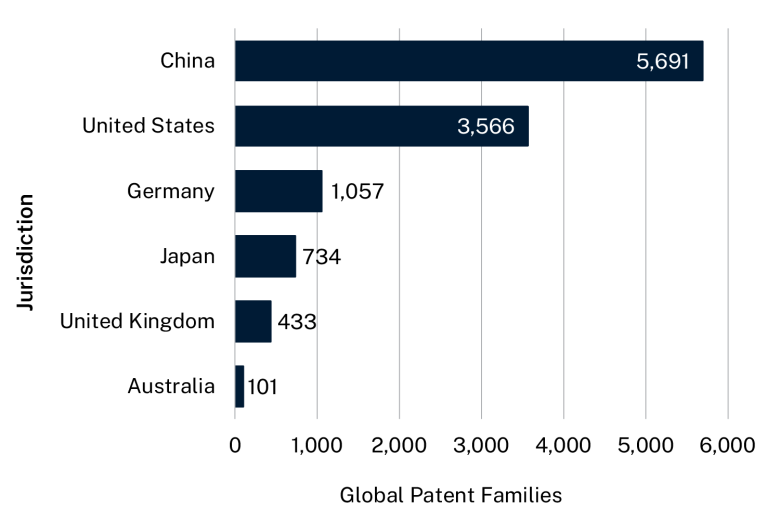Quantum technologies take advantage of the way matter and light behave at atomic and subatomic scales. Quantum mechanical properties (like entanglement, superposition and tunnelling) can be used to build advanced technologies that would otherwise be impossible.
Example technologies
- Quantum computing
- Post-quantum cryptography
- Quantum communications
- Quantum sensors
Example applications
These technologies can be used for:
- improved data security, management and analysis
- modelling and simulation to discover new drugs and next-generation materials
- quantum networks that increase computing capability
- optimising logistics and utilities sectors such as energy, waste management and banking
- improving measurement accuracy, including for sea water levels and underground water tables
- underground leak and earthquake detection
- medical imaging
- mineral detection.
Global research trends
Research into quantum technologies has been growing steadily over the past 10 years, with over 37,000 quantum research publications published around the world in 2021.
Global research rankings
China and the United States do the most quantum research.
The graph below shows the number of publications each published between 2018 and 2022. It also shows what proportion of each jurisdiction’s publications were ranked in the top 10% of publications worldwide. This is based on how often the jurisdiction’s publications on core quantum research subjects were cited.
Quantum publications by jurisdiction, 2018–22

|
Ranking |
Jurisdiction |
Publications, 2018 to 2022 |
Percentage in top 10% of publications |
|---|---|---|---|
|
1 |
China |
54,401 |
9.75% |
|
2 |
USA |
32,508 |
18.5% |
|
3 |
Germany |
15,461 |
12.22% |
|
4 |
India |
14,265 |
7.61% |
|
5 |
UK |
10,582 |
13.92% |
|
6 |
Russia |
10,239 |
6.05% |
|
7 |
Japan |
9,776 |
12.97% |
|
8 |
France |
8,568 |
12.12% |
|
9 |
Italy |
7,738 |
12.06% |
|
10 |
South Korea |
6,229 |
9.2% |
|
14 |
Australia |
4,186 |
12.62% |
Commercialisation
Patent filings are a way to measure how innovation is being commercialised. Patent data can also be used to identify potential collaborators and export markets.
The graphs below show numbers of patent families filed. A patent family is a set of patents filed in different jurisdictions for the same invention.
Quantum patent families filed globally each year, 2017–2021

|
Year |
Global patent families filed |
|---|---|
|
2017 |
1847 |
|
2018 |
2234 |
|
2019 |
2587 |
|
2020 |
2789 |
|
2021 |
1374 |
Jurisdiction of origin for quantum patent families filed, 2017–2021

|
Ranking |
Jurisdiction |
Global patent families filed |
|---|---|---|
|
1 |
China |
5691 |
|
2 |
United States |
3566 |
|
3 |
Germany |
1057 |
|
4 |
Japan |
734 |
|
5 |
United Kingdom |
433 |
|
12 |
Australia |
101 |
The Australian industry
Australia has always been a leader in quantum research, especially in diamond quantum sensors. We contributed to important early quantum research and have invested significantly in research over several decades.
The Australian Government published the National Quantum Strategy in May 2023. The strategy sets out a long-term vision to grow the quantum industry in Australia.
Quantum research output (number of publications) by state and territory, 2018–2022

- NSW: 37%
- Victoria: 23%
- Queensland: 15%
- ACT: 13%
- Western Australia: 7%
- South Australia: 4%
- Tasmania: 1%
- Northern Territory: less than 1%
Collaboration
The jurisdictions we collaborate with most on quantum research are China, the United States, the United Kingdom, Germany and Japan.
Australia’s top 5 global collaborators on quantum research, 2018–2022

- China: 1,111 publications
- United States: 751 publications
- United Kingdom: 450 publications
- Germany: 425 publications
- Japan: 267 publications
Australia wants to be a leader in developing international technical standards for quantum. We are supporting Australian industry to engage more effectively with standards development organisations.
The future
While our quantum sector is smaller than those of China and the United States, we can have a leading role in the global industry by:
- building on our research strengths and world-class quantum talent
- catering to niche markets such as quantum sensing in resources and space exploration
- manufacturing more quantum technologies in Australia.
Market opportunities
The global market for quantum computing is expected to grow by 30% a year over the next 5 years.
In Australia, quantum technologies could contribute $6.1 billion to GDP by 2045, including $2.4 billion in general productivity gains. By 2045 our industry could directly employ 19,400 people and create more than 35,000 jobs across the economy.
But if we speed up our development and adoption of quantum technologies, they could add as much as $9 billion to the economy and generate over 50,000 jobs by 2045.
Data sources
Publication and citation data on this page was collected from Clarivate’s Web of Science and InCites. Data analysis was performed by CSIRO.
Patent data collection and analysis was performed by IP Australia using data from the European Patent Office’s PATSTAT 2022 autumn edition.

